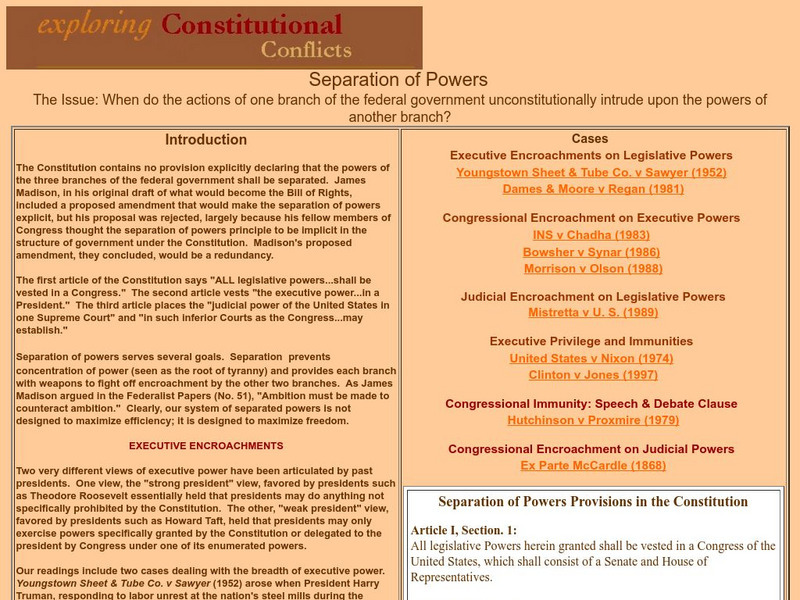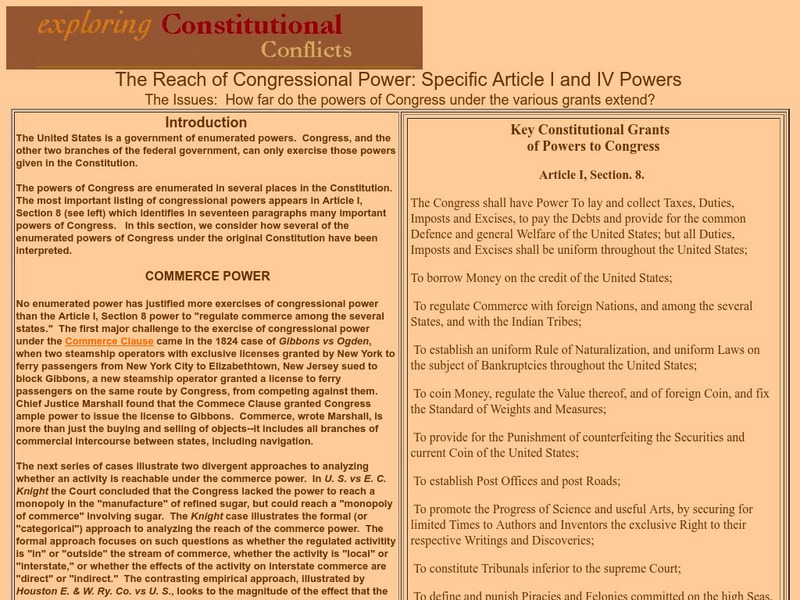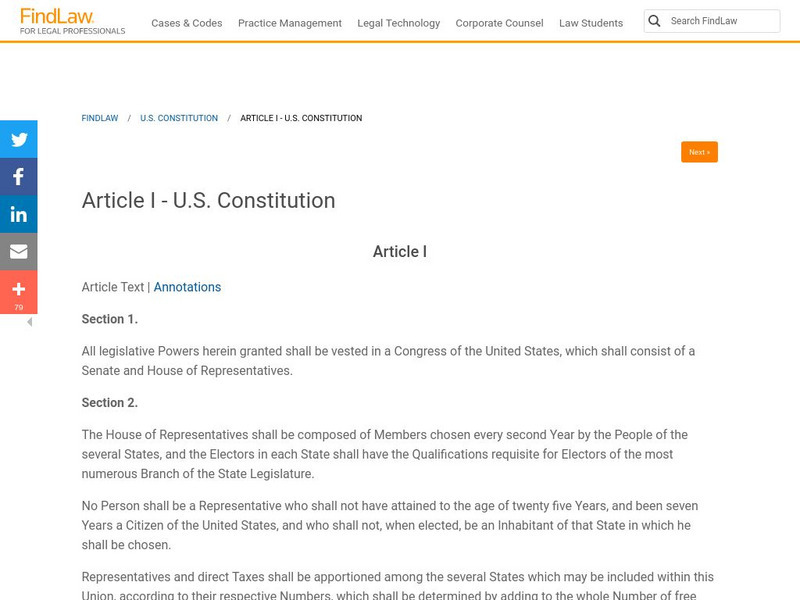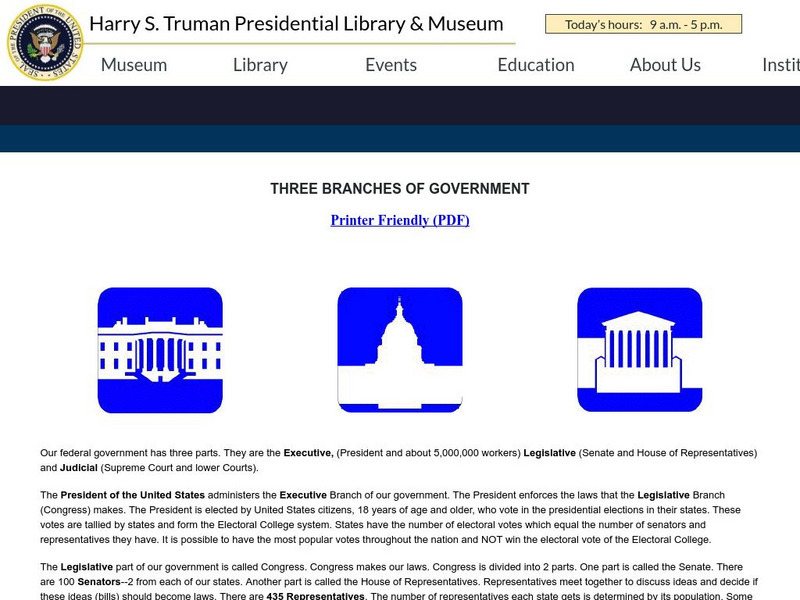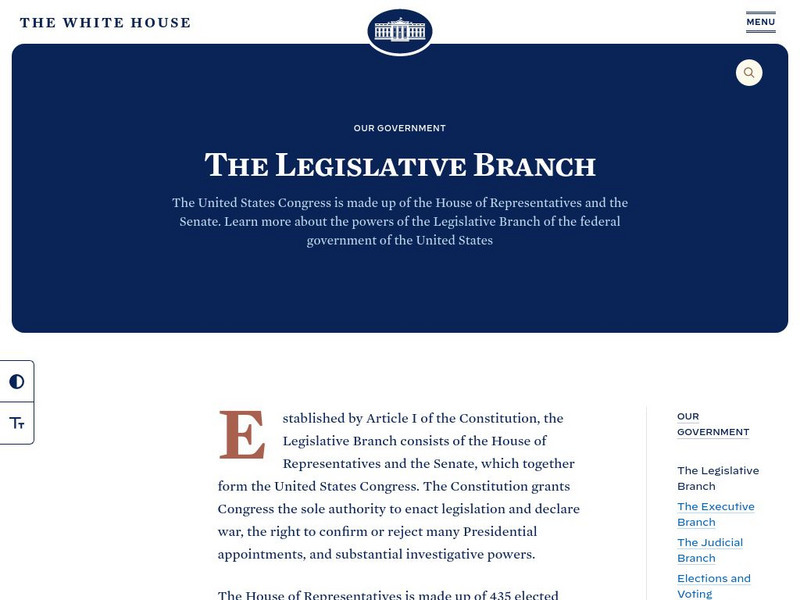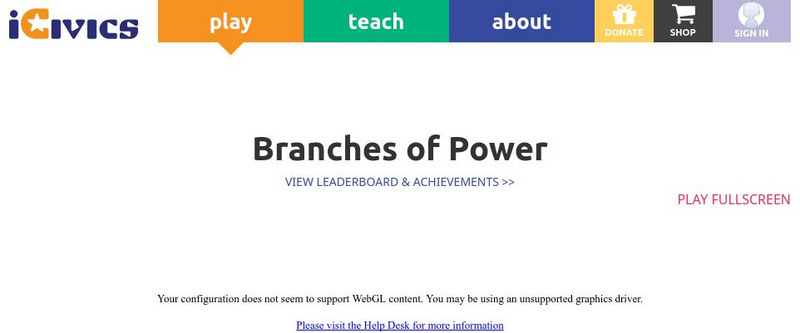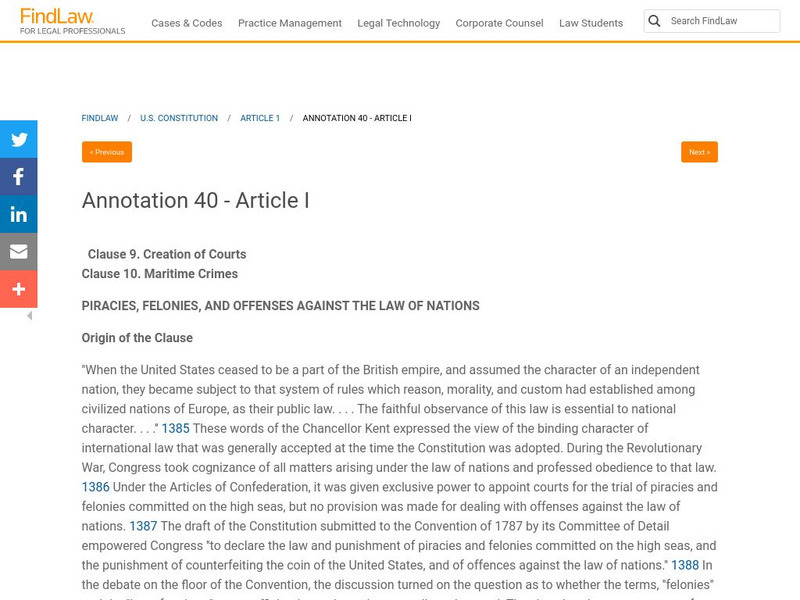Hi, what do you want to do?
University of Missouri
Exploring Constitutional Conflicts: Separation of Powers
When do the actions of one branch of the federal government unconstitutionally intrude upon the powers of another branch? This article surveys the history of this question in historic Supreme Court cases.
PBS
Structure of Congress and the Legislative Process Lesson
This instructional activity explores the structure of Congress and the legislative process. There is an introduction, a research activity, an assessment, and a role play activity.
Utah Education Network
Uen: Themepark: Liberty: Three Branches of Government
Find a large collection of internet resources organized around the three branches of government. Links to places to go, people to see, things to do, teacher resources, and bibliographies.
University of Missouri
Exploring Constitutional Conflicts: The Reach of Congressional Power
Read about the privileges and powers exercised by Congress from a constitutional law perspective. Includes examples of many cases which have tested the limits of Congressional power in the history of the United States. Many links to...
A&E Television
History.com: How John Marshall Expanded the Power of the Supreme Court
When John Marshall was appointed chief justice of the U.S. Supreme Court in 1801, the nation's highest court occupied a lowly position. There was no Supreme Court Building in the newly completed capital, Washington, D.C., so the six...
Thomson Reuters
Find Law: u.s. Constitution: Article I
Complete text of Article I, sections 1-10, of the U.S. Constitution, establishing the Legislative Branch of the Federal government.
PBS
Pbs Learning Media: The Powers of Government
Students learn how the three branches of the United States government work together and the powers that the Constitution assigns to each branch-legislative, executive, and judicial.
Harry S. Truman Library and Museum
Harry S. Truman Library & Museum: Three Branches of Our Government
This slide and the six that follow it (use the advance button near the bottom of the screen) offer an explanation of each of the three branches of government and the duties they perform, including discussion of the tensions arising from...
US Government Publishing Office
Ben's Guide to u.s. Government: Branches of Government
A brief overview of the origins of the three branches of the federal government, with links to more in-depth information about each branch. Also discusses the concerns of the Founding Fathers about creating a government that had...
The White House
The White House: The Legislative Branch
A brief summary of the the Legislative Branch of government and guidelines for membership. The powers of Congress, the legislative process, and even the oversights made by government, to prevent abuse of power, are discussed.
US Government Publishing Office
Ben's Guide to u.s. Government: President's Legislative Powers
An easy-to-understand discussion on the actual legislative powers of the president and the veto. Includes related links.
US Government Publishing Office
Ben's Guide to u.s. Government: Judicial Branch (9 12)
Provides a brief overview of the judicial branch of the federal government. Discusses the origin of the judicial branch, the concept of judicial review, and functions of the judicial branch. Links to more information about the U.S....
US Mint
United States Mint: Branches of Power
Save the federal government from Oppressor Sam, and learn about the US Constitution to restore the three branches of government.
Harry S. Truman Library and Museum
Harry S. Truman Library & Museum: Checks and Balances
Descriptions of the separate powers and functions of the three branches of the federal government. Site explains how the powers of one branch check and balance those of another.
iCivics
I Civics: Branches of Power
Do you like running things? Branches of Power allows you to do something that no one else can: control all three branches of government! You'll have the power to write any laws you want about issues you choose. Careful, though, there's a...
US National Archives
National Archives: What Congress Does and Why It Matters
Learners will analyze primary sources related to Congress to learn the specific powers of the Legislative Branch. Included is a chart to download and print, worksheets, materials, and an answer key. Primary sources to be examined are...
US Government Publishing Office
Ben's Guide to u.s. Government: Learning Adventures: Branches of Government
Introduction to a learning adventure on the Constitution and branches of government. Students click on their age group icon to find information on which part of the Constitution spells out the powers of legislative, executive and...
US National Archives
Docs Teach: Separation of Powers or Shared Powers
In this activity, students will analyze documents that illustrate the relationship between the legislative, executive and judicial branches. Using the scale in Weighing the Evidence, students will decide whether the United States...
Other
Usa Gov: Three Branches of Government
Lesson plans for students to learn about the three branches of government. They can find information about the origins of the Constitution, separation of powers, and details about each of the three branches.
Siteseen
Siteseen: Government and Constitution: Branches of Government
This article contains a useful guide to the functions of the three US Branches of Government that make, enforce, or interprets laws.
American Bar Association
American Bar Assoc.: Separation of Powers, Connecting the Separate Powers [Pdf]
This lesson plan involves role-playing to help the students understand the separation of powers. [PDF]
The White House
The White House: Our Government
Overviews of the major elements of U.S. government, compiled and published by the White House: three branches of the federal government (executive, legislative, judicial), the Constitution, federal agencies and commissions, elections and...
iCivics
I Civics: Mini Lesson: Executive Orders
Students discover how presidents use executive orders to wield power and how the legislative and judicial branches support and challenge these measures.
Thomson Reuters
Find Law: Piracies, Felonies, and Offenses Against the Law
This resource explains Clause 10 of Article I of the U.S. Constitution beginning with the origins of "Piracies, Felonies, and Offenses Against the Law of Nations." Further historical background as considered by the Constitutional...





